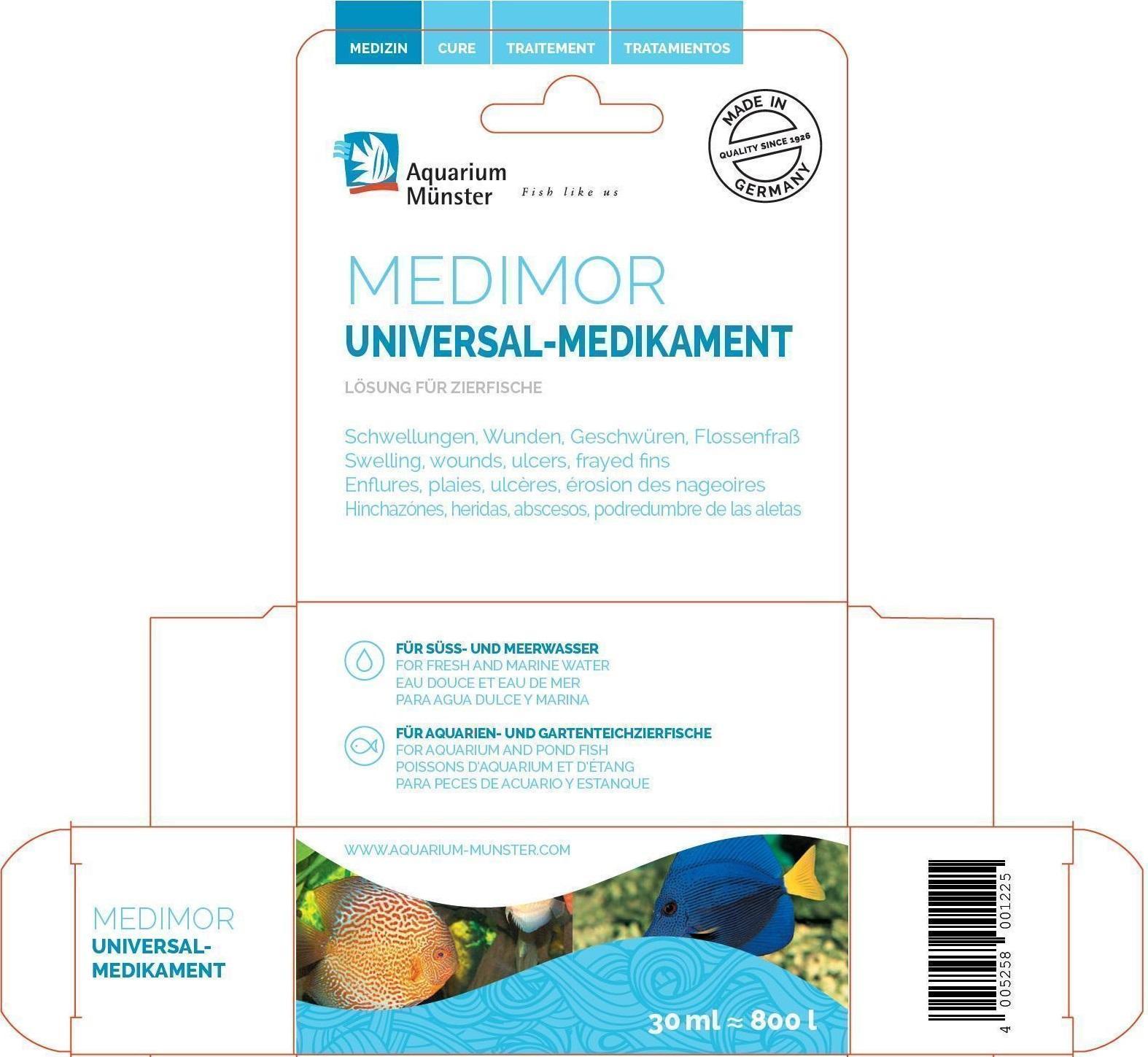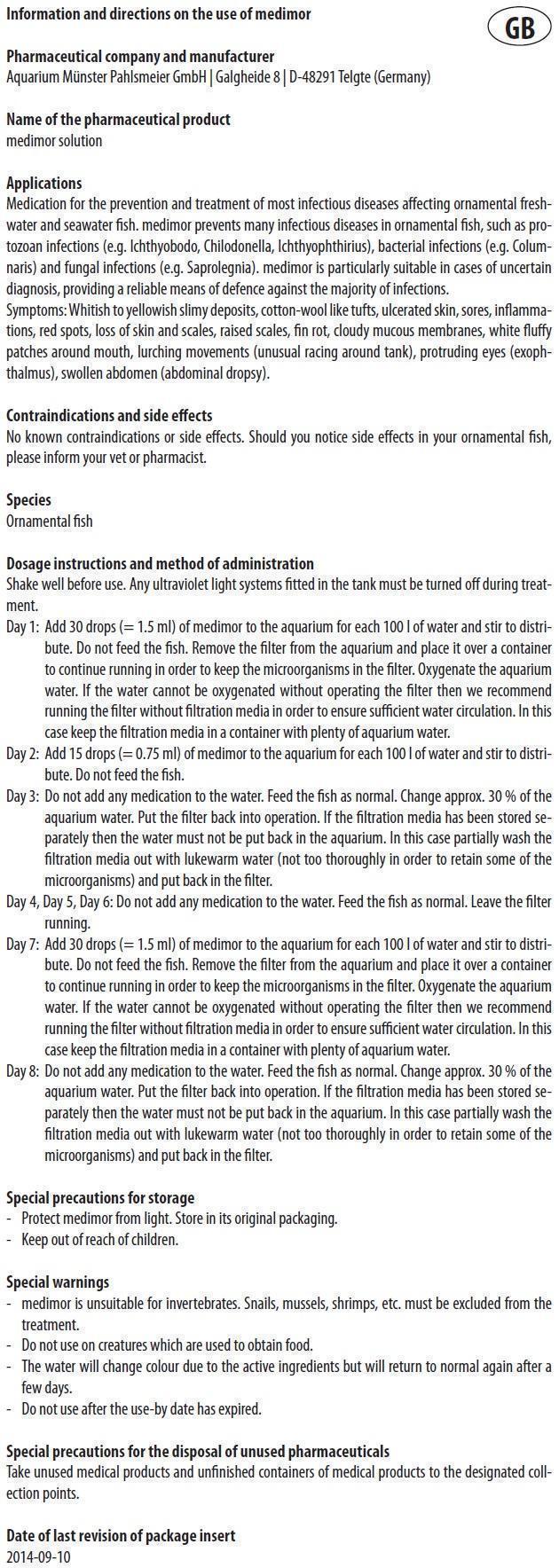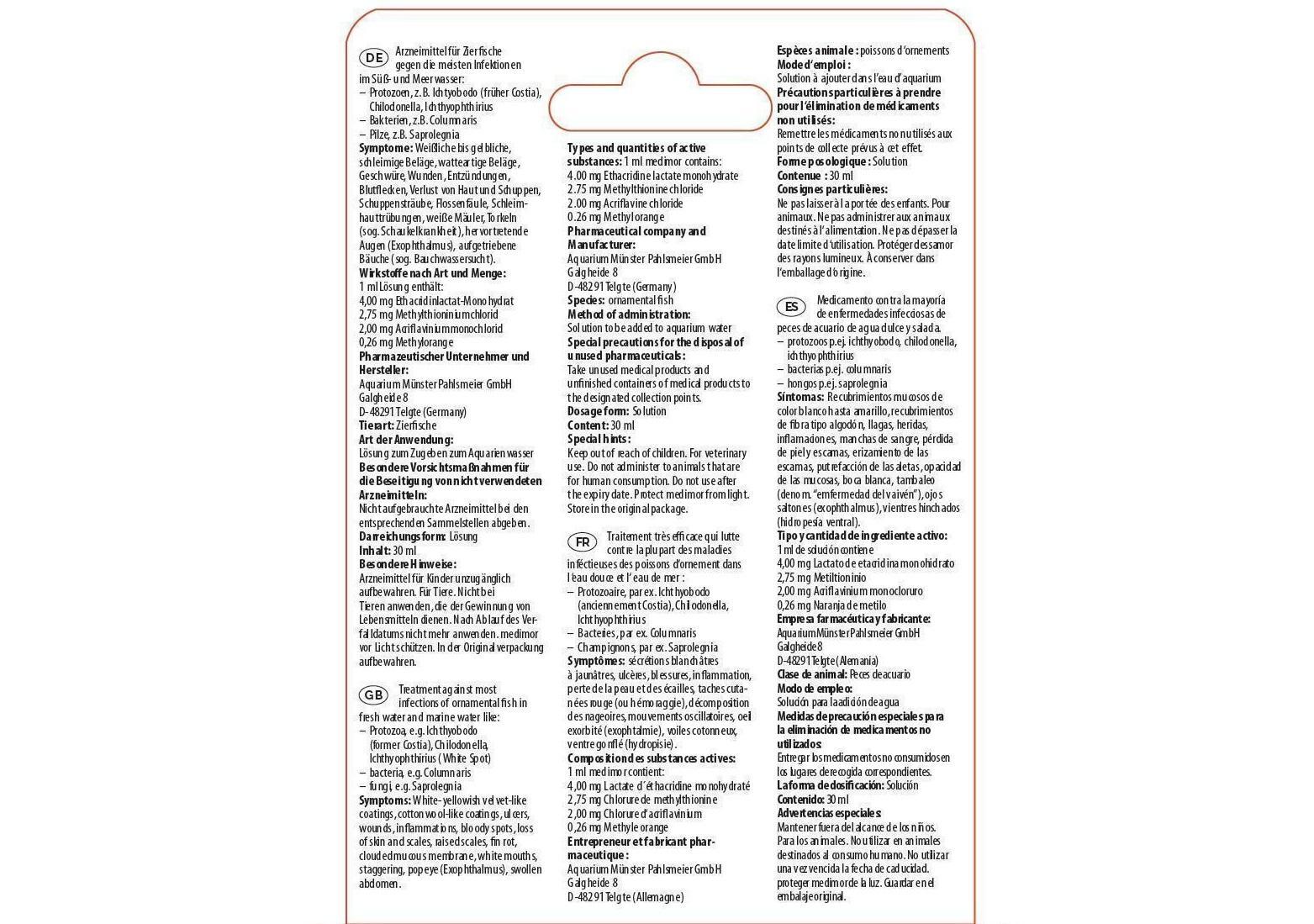Animal NDC 86052-004-01 Medimor
Ethacridine Lactate, Methylene Blue Anhydrous
Animal Product Information
Medimor Images
Medimor Animal Product Labeling Information
The product labeling information includes all published material associated to a drug. Product labeling documents include information like generic names, active ingredients, ingredient strength dosage, routes of administration, appearance, usage, warnings, inactive ingredients, etc.
Table of Contents
- Information And Directions On The Use Of Medimor
- Applications
- Types And Quantities Of Active Substances:
- Contraindications And Side Effects
- Species
- Dosage Instructions And Method Of Administration
- Special Precautions For Storage
- Special Warnings
- Special Precautions For The Disposal Of Unused Pharmaceuticals
- Product Label
Information And Directions On The Use Of Medimor
Pharmaceutical company and manufacturer
Aquarium Münster Pahlsmeier GmbH | Galgheide 8 | D-48291 Telgte (Germany)
Name of the pharmaceutical product
medimor solution
Applications
Medication for the prevention and treatment of most infectious diseases affecting ornamental freshwater and seawater fish. medimor prevents many infectious diseases in ornamental fish, such as protozoan infections (e.g. Ichthyobodo, Chilodonella, Ichthyophthirius), bacterial infections (e.g. Columnaris) and fungal infections (e.g. Saprolegnia). medimor is particularly suitable in cases of uncertain
diagnosis, providing a reliable means of defence against the majority of infections. Symptoms: Whitish to yellowish slimy deposits, cotton-wool like tufts, ulcerated skin, sores, inflammations, red spots, loss of skin and scales, raised scales, fin rot, cloudy mucous membranes, white fluffy patches around mouth, lurching movements (unusual racing around tank), protruding eyes (exophthalmus),
swollen abdomen (abdominal dropsy).
Types And Quantities Of Active Substances:
1 ml medimor contains:
4.00 mg Ethacridine lactate monohydrate
2.75 mg Methylthionine chloride
2.00 mg Acriflavine chloride
0.26 mg Methyl orange
Contraindications And Side Effects
No known contraindications or side effects. Should you notice side effects in your ornamental fish, please inform your vet or pharmacist.
Species
Ornamental fish
Dosage Instructions And Method Of Administration
Shake well before use. Any ultraviolet light systems fitted in the tank must be turned off during treatment.
Day 1: Add 30 drops (= 1.5 ml) of medimor to the aquarium for each 100 l of water and stir to distribute. Do not feed the fish. Remove the filter from the aquarium and place it over a container to continue running in order to keep the microorganisms in the filter. Oxygenate the aquarium water. If the water cannot be oxygenated without operating the filter then we recommend running the filter without filtration media in order to ensure sufficient water circulation. In this case keep the filtration media in a container with plenty of aquarium water.
Day 2: Add 15 drops (= 0.75 ml) of medimor to the aquarium for each 100 l of water and stir to distribute. Do not feed the fish.
Day 3: Do not add any medication to the water. Feed the fish as normal. Change approx. 30 % of the aquarium water. Put the filter back into operation. If the filtration media has been stored separately then the water must not be put back in the aquarium. In this case partially wash the filtration media out with lukewarm water (not too thoroughly in order to retain some of the microorganisms) and put back in the filter.
Day 4, Day 5, Day 6: Do not add any medication to the water. Feed the fish as normal. Leave the filter running.
Day 7: Add 30 drops (= 1.5 ml) of medimor to the aquarium for each 100 l of water and stir to distribute. Do not feed the fish. Remove the filter from the aquarium and place it over a container to continue running in order to keep the microorganisms in the filter. Oxygenate the aquarium water. If the water cannot be oxygenated without operating the filter then we recommend running the filter without filtration media in order to ensure sufficient water circulation. In this case keep the filtration media in a container with plenty of aquarium water.
Day 8: Do not add any medication to the water. Feed the fish as normal. Change approx. 30 % of the aquarium water. Put the filter back into operation. If the filtration media has been stored separately then the water must not be put back in the aquarium. In this case partially wash the filtration media out with lukewarm water (not too thoroughly in order to retain some of the microorganisms) and put back in the filter.
Special Precautions For Storage
- Protect medimor from light. Store in its original packaging.
Special Warnings
- medimor is unsuitable for invertebrates. Snails, mussels, shrimps, etc. must be excluded from the treatment.
- Do not use on creatures which are used to obtain food.
- The water will change colour due to the active ingredients but will return to normal again after a few days.
- Do not use after the use-by date has expired.
Special Precautions For The Disposal Of Unused Pharmaceuticals
Take unused medical products and unfinished containers of medical products to the designated collection points.
Date of last revision of package insert
2014-09-10
Product Label
* The information on this page is for an ANIMAL PRODUCT, please review the complete disclaimer below.


